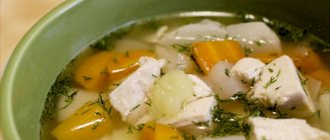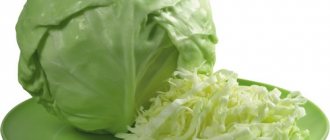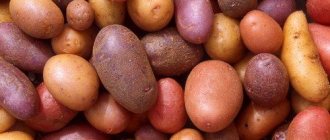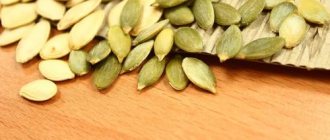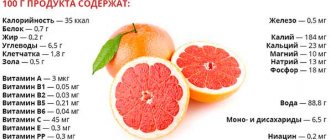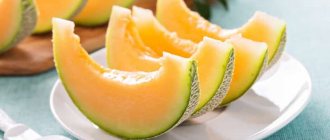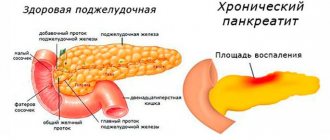Avocado is one of the most versatile fruits. It is used to prepare sauces for meat, fish, and vegetable dishes, and added to all kinds of salads and numerous sweet or savory snacks. This product is recommended by nutritionists for creating menus for various diseases. Avocado for pancreatitis can bring both benefit and harm to the body, depending on the patient’s condition, stage of the disease, and the presence of concomitant pathology.
What kind of fruit is avocado, and what are its benefits and harms for a sick body?
Avocado is an exotic fruit that also has another name - alligator pear. Its composition is rich in many valuable substances for the body that take part in all metabolic processes in the human body:
- vegetable proteins, essential amino acids,
- fats, represented by healthy polyunsaturated fatty acids,
- complex carbohydrates (vegetable fiber),
- vitamins (A, E, C, K, PP, almost all representatives of group B),
- trace elements (potassium, magnesium, iron, calcium, copper, zinc, selenium, manganese).
These components have many beneficial effects on the entire body, including on the condition of the pancreas in pancreatitis, cholecystitis, enterocolitis and other diseases of the gastrointestinal tract:
- Accelerate the recovery of tissues damaged during the inflammatory process. Therefore, avocados are recommended for many diseases of the gastrointestinal tract, including the pancreas (pancreatitis, diabetes mellitus), gall bladder, and liver (hepatosis).
- Improve immunity, increase the body's defenses necessary to effectively fight inflammation.
- Reduce inflammation in the pancreas and other gastrointestinal organs.
- They cause an antioxidant effect, as a result of which free radicals dangerous to the body are neutralized, and the likelihood of developing malignant tumors is reduced.
- Normalizes hematopoietic processes.
- Healthy fatty acids, such as Omega-3, help eliminate bad cholesterol, thereby preventing the development of atherosclerosis. As a result, the likelihood of the formation of atherosclerotic plaques in the arteries is reduced, and the blood supply to all internal organs, including the pancreas, is improved.
- The plant fiber of the fruit helps to enhance the motility of the digestive tract. This is manifested by a choleretic effect, mild elimination of constipation, and normalization of the composition of intestinal microflora.
The danger of eating alligator pear is that it is a rather fatty product, difficult to digest in case of pancreatitis, accompanied by enzymatic deficiency. In addition, increased intestinal motility due to the presence of fiber in avocados aggravates the symptoms of pancreatitis: increased nausea, vomiting, abdominal cramps, flatulence and diarrhea.
Avocado during remission of chronic pancreatitis
Patients with pancreatitis can include avocado in their diet two months after an exacerbation, provided they feel well. The tolerance of the fruit is determined by introducing its pulp one teaspoon at a time. Confirmation of the normal digestibility of avocado will be the absence of diarrhea, flatulence and pain - in this case, the serving size is gradually increased, bringing it to approximately 100 g (half a medium-sized fruit).
Avocado can be eaten separately, scooping out its pulp with a spoon or pureeing it using a blender, or you can add pieces of the peeled fruit to fruit and vegetable salads. It goes very well with fish and seafood allowed for sick people; it is also served as a side dish for meat. If desired, avocado slices can be baked, but it will be less healthy.
The consumption of spicy snacks, pastes and sauces made from avocado, including the famous guancamole sauce, is prohibited. It should be noted that the peeled fruit pulp quickly darkens in air, to prevent which it is usually sprinkled with lemon or lime juice. In case of pancreatitis, acidic juices are excluded from the menu, so avocados should be peeled immediately before eating.
Is it possible to eat avocados if you have pancreatic diseases?
The beneficial properties of this fruit contribute to recovery from pancreatitis. But before eating any dish with it, you must consult with a specialist - a nutritionist, gastroenterologist or therapist.
The doctor will determine the stage of the disease, identify concomitant pathologies in which it is undesirable to eat avocados, and determine whether the patient has an individual intolerance to the components of the fruit.
Avocado in the acute stage of pancreatitis
Acute inflammation of the pancreas is accompanied by painful symptoms of pain and dyspeptic syndrome. The therapeutic diet at this stage of the disease involves mechanical, temperature, and chemical sparing of the mucous membranes of the digestive tract: you cannot eat hot, cold, spicy, bitter or coarse-textured dishes. Consumption of this fruit during this period is contraindicated, since it is too fatty and requires a large amount of enzymes to digest it. In addition, its plant fibers will provoke increased diarrhea and bloating.
Consumption during the remission stage of chronic pancreatitis
After acute inflammatory symptoms have subsided and pancreatitis has reached the stage of remission, it is possible to introduce avocados into the diet. The doctor recommends eating this fruit only if there are no complaints of abdominal pain, nausea, increased gas formation, or diarrhea. To confirm the stage of remission, specialists prescribe the patient to undergo special tests and undergo an ultrasound examination of the abdominal organs, the results of which confirm the absence of an inflammatory process in the body.
The rationale for using the fetus for pancreatitis
This fruit has many beneficial properties: it contains bromelain, as well as potassium, copper, manganese, phosphorus, etc.
But the presence of many healing properties does not imply complete safety when using it. Even taking into account the fact that avocado vegetable fats are healthy, if you have pancreatic diseases, it is undesirable to consume them in large quantities.
Despite the fact that it is used in many therapeutic and preventive diets, avocado consumption during pancreatitis should be limited. This is due to the high fat content of its pulp.
Among other things, the fruit contains a lot of fiber, which in large quantities can harm the damaged organ, cause colic and bloating, and provoke a relapse of the disease.
What to cook from avocado if you are sick?
Many healthy and tasty dishes can be prepared from avocado pulp for pancreatitis, cholecystitis and other gastrointestinal diseases. Due to the fact that it is not recommended to heat treat the fruit, it is most often added to various salads, sauces for meat and fish dishes.
Meat salad with avocado
To prepare it you will need dietary meat, best of all - chicken breast, 1 avocado, herbs (dill, parsley), fresh cucumber, a pinch of salt.
The recipe for this salad is very simple:
Considering the composition of this hearty, tasty dish, it can only be consumed at the stage of stable long-term remission of the disease after the permission of the attending physician.
Avocado milkshake
This is a very healthy and tasty drink that saturates the body with protein, a large amount of vitamins and minerals. To prepare the cocktail you will need 1 avocado, a glass of milk, a tablespoon of honey. Drink preparation steps:
Fruit salad with avocado
This is a very tasty, healthy dessert. Avocado goes well with many fruits and berries. According to one of the recipes for preparing the salad, you will need 1 avocado, kiwi, half a glass of strawberries, a spoonful of honey, a little coconut and sesame seeds. Salad preparation steps:
Avocado oil
The use of alligator pear oil to restore the pancreas and liver is also considered useful. The course of treatment with this product is approximately 2 weeks. You should drink the oil before meals in the amount prescribed by a specialist.
Avocado is a very healthy, high-calorie fruit. Its use is permitted during the treatment of pancreatitis at the stage of remission. During an exacerbation, you should not eat fruit, as it can worsen the patient’s well-being due to increased abdominal pain, gas formation in the intestines and diarrhea. When the patient’s condition is normalized, many avocado dishes or drinks are allowed to be introduced into the diet.
Similar products
Eating berries and fruits that are similar to avocados will be very beneficial for the body when suffering from pancreatitis.
- Olives with olives.
- Lemon.
- Cranberry.
- Sea buckthorn.
- Black currant.
- Strawberry.
- Grapefruit.
- Mandarin.
These products, like avocados, should not be consumed during the acute period of pancreatitis, but carefully, with the permission of a doctor, during the remission stage. It is important to immediately go to the doctor to prescribe treatment if symptoms of an attack of pancreatitis appear.
Avocado for pancreatitis
Diseases of the stomach and pancreas require the patient to follow a strict diet. The list of prohibited foods includes fatty, spicy, salty, smoked foods, as well as some vegetables and fruits. Is it possible to eat avocado with pancreatitis and cholecystitis?
Avocado for pancreatitis
Pancreatitis is characterized by acute and chronic course. The answer to the question whether it is possible or not depends on the clinical picture and the exact diagnosis. Before preparing a diet, the patient must consult with a gastroenterologist, therapist and nutritionist and strictly follow all the recommendations of specialists.
Acute stage
Acute inflammation of the pancreas is accompanied by colic, causing severe pain, vomiting, and bloating. Often the patient's temperature rises and the heartbeat quickens.
Patients are prescribed a strict therapeutic diet: you cannot eat avocado during acute pancreatitis. The reason is the high fat content; large quantities of enzymes are needed for digestion and absorption. And this is an additional burden on the pancreas and digestive organs as a whole.
The tropical fruit contains a lot of fiber - it provokes flatulence, constipation and exacerbation of the disease.
It is allowed to introduce it into the diet no earlier than 2-2.5 months after the attack, monitoring the body’s reaction. With low activity of pancreatic enzymes, an exotic fruit can cause diarrhea. In this case and with any other negative changes, it will have to be excluded from the diet.
Chronic stage
If you have chronic pancreatitis, you can and should eat avocados. It contains no sugar, which has a positive effect on the gastrointestinal tract. The tropical fruit is a source of vitamins, valuable acids and microelements necessary for the absorption and digestion of food.
The unsaturated fatty acids included in the composition normalize fat metabolism, and dietary fiber, potassium and other microelements restore beneficial intestinal microflora.
Taking the product for chronic conditions is allowed only during the period of remission. The patient must first pass tests and undergo an ultrasound of the abdominal cavity. If there is no inflammatory process, you can introduce the fruit into the diet menu.
How to use?
Eating avocados for pancreatitis starts with 1 teaspoon. The fruit is first peeled, the pulp is mashed to a puree consistency and eaten fresh.
If you feel normal – without vomiting, nausea, heartburn, bowel dysfunction – you can increase the serving size, gradually bringing it up to 100 g.
The pulp of the fruit is eaten fresh, since when baked, boiled and other heat treatments it partially loses its benefits. This happens due to the destruction of a large number of useful elements. The taste of the tropical fruit also changes.
You need to peel and select the pulp immediately before use - it quickly becomes weathered and darkens.
Avocado for cholecystitis
Cholecystitis is inflammation of the gallbladder. The function of this organ is to secrete bile, which is involved in the digestion process and accelerates the breakdown of fats and protein.
There are two stages of cholecystitis: acute and chronic. In an acute case, a person complains of pain under the ribs on the right side, he feels chills, feels nauseous, and may vomit. The symptoms are very similar to an attack of pancreatitis.
Avocados should not be consumed in this state. Substances in its composition stimulate the bile ducts, accelerating the outflow of bile. If there are stones and one duct is blocked, the secretion does not enter the intestines - this becomes the cause of colic and acute abdominal pain.
The chronic course is characterized by a dull aching pain in the liver area. It usually appears after eating and is often accompanied by bitterness in the mouth and bloating, so doctors prescribe dietary nutrition to patients.
The purpose of the diet is to minimize the burden on digestion, relieve inflammation, and dilute the secretions secreted by the gallbladder. Avocado is included in the list of permitted foods due to its balanced composition:
- proteins of plant origin;
- vegetable fiber;
- polyunsaturated fatty acids;
- vitamins A, B, C, E, K, PP;
- potassium, calcium, iron, magnesium, selenium and other trace elements.
Avocado for gastritis
The causative agent of gastritis is the bacteria helicobacter pilori; due to infection, the gastric mucosa becomes inflamed. Any irritation of the walls of an internal organ causes pain.
During treatment and during remission, patients must adhere to a diet. They are prohibited from fried, salty, spicy, fatty, spicy, and sweet foods. Fruits should be peeled first. At the same time, the diet should be rich in vitamins - avocado is unrivaled by this criterion.
People with high acidity are allowed to eat only ripe fruits. Unripe fruits will not bring any benefit to the body. The fruit is first peeled, divided into slices and eaten in vegetable salads or with boiled, steamed fish.
The pulp can be consumed in its pure form, but it has a specific, pumpkin-herbal taste. The taste varies depending on the variety: some fruits have a creamy, nutty, buttery taste.
Half an avocado per day is considered a safe norm for patients with gastritis. Taking it in larger quantities can aggravate the condition due to the high fat content in the pulp.
How to eat fruit correctly?
- People with pancreatitis, gastritis and other gastrointestinal diseases are not advised to consume the fruit on an empty stomach due to its high fat content.
- The ideal time is a snack or lunch. You will have to refrain from taking it in the evening. It takes 2-3 hours to digest it - this is an unnecessary burden on the stomach and intestines.
- Garlic, mayonnaise, spices, canned fish and meat, and other products from the “stop list” should not be added to salads and other dishes based on tropical fruits. Otherwise, the condition may worsen.
- You cannot combine the fruit with fatty foods. The ideal combination is chicken fillet and vegetables.
- Peeled avocados should not be stored in the refrigerator for more than a day. It is best to eat it within 10-15 minutes after cutting.
Following these simple rules will not only not worsen your health, but will significantly improve your well-being and bring maximum benefit to the body.
Composition and benefits of avocado
The fruit is rich in fats (14.6 g), carbohydrates (1.83 g) and proteins (2 g). Its calorie content is quite high - approximately 160 kcal per 100 grams. Despite its high nutritional value, the green fruit’s compliance with a proper diet for chronic pancreatic inflammation is assessed at five.
Eating avocado for pancreatitis is indicated because it contains many beneficial substances. These are organic acids, including alpha-linolenic acid, which normalizes metabolic processes and removes harmful cholesterol from the body.
Cholecystitis - diet for acute inflammation
The goal of the diet is to reduce the load on the gallbladder and liver and improve the flow of bile. A couple of days after the attack, when the pain syndrome is no longer so pronounced, the patient can eat:
- slimy soups from oatmeal, rice, semolina;
- pureed porridge from these cereals;
- fruit jellies, mousses and jellies.
After a few days, low-fat cottage cheese, meat and fish are included in the diet. Food should be steamed or boiled. Before serving to the patient, grind and make sure the dish is warm. Cold and hot foods can cause pain.
According to nutritionist Arthur Moiseenko , with inflammation of the gallbladder, the absorption of fat-soluble vitamins from food deteriorates. Their deficiency negatively affects the patient's health. Therefore, patients are recommended to take multivitamin complexes, including vitamins A, E, D, K.
pixabay.com/Mizianitka
